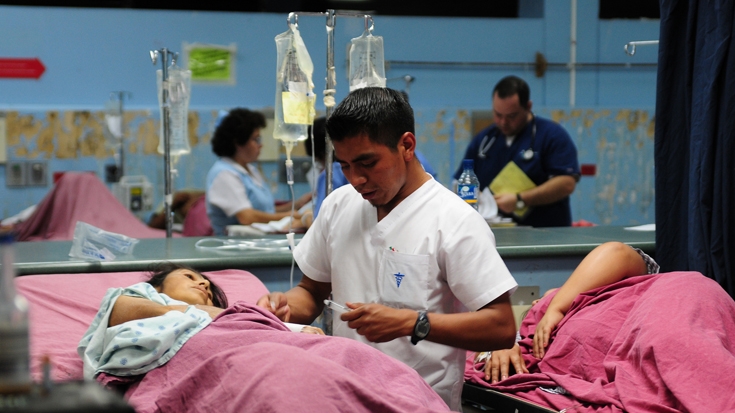Challenges
Guatemala’s high maternal mortality rates were the result of inequities in access to health services. In the early 2000s, one in five pregnant women had no pre-natal care at all, and half had their first pre-natal care visit during the first trimester of pregnancy. Low birth weight, deliveries under unsafe conditions, malnutrition, infectious digestive diseases, and respiratory infections raised infant mortality. Furthermore, Guatemala had the highest prevalence of chronic malnutrition (stunting) in the region, with half of all preschool children chronically malnourished. Chronic malnutrition and the poor health of young children not only led to higher infant mortality, but also short stature, negative cognitive development, poor school performance, and reduced adult productivity. The resulting irreversible losses of human capital formation affect current and future generations and will ultimately undermine the country’s economic growth.
Solution
To address some of the root causes of Guatemala’s health crisis, in 2005, the Guatemalan Government sought to increase health care access by strengthening the Extension of Coverage Program (Programa de Extensión de Cobertura, PEC). The program guaranteed the universal provision of an improved basic package of health services in over 100 largely rural and vulnerable municipalities through a two-phase approach. The first phase was implemented in 41 prioritized municipalities. The Bank’s Maternal-Infant Health and Nutrition Project supported the second phase of the PEC, which expanded coverage to an additional 70 municipalities. Through the Extension of Coverage Program and other health and nutrition related interventions, the project worked to improve maternal and infant health in the areas of intervention and reduce chronic malnutrition among children younger than two years of age in rural areas. Other interventions included strengthening 40 secondary level facilities to promote safe births, and supporting community-based and institutional integrated maternal and child nutrition centers.
Results
The following key outcomes in health improvements were measured among the target population (pregnant women and children under two years of age) in the areas of intervention:
- The indigenous/non-indigenous maternal mortality ratio fell from 3.2 percent in June 2006 to 1.24 percent in December 2012.
- The percentage of institutional deliveries increased from 22.3 percent in 2006 to 42 percent in December 2012.
- The percentage of children with chronic malnutrition fell from 73 percent to 60 percent.
Bank Group Contribution
A US$49 million Bank loan supported the Maternal and Infant Health and Nutrition Project. This was the first Bank financed project in the health sector in Guatemala. In addition, the Bank provided significant project-related technical assistance and was closely engaged on the ground.
Partners
The Ministry of Public Health and Social Welfare (MSPAS) implemented the project, provided all relevant data and complied with the loan’s conditions, including social and environmental safeguards to make the project successful. The Bank team worked in close collaboration with the MSPAS Health Team to design the project and remained engaged during program implementation. The Inter-American Development Bank’s Mesoamerican Health Initiative 2015—Guatemala Project also seeks to improve maternal health, reproductive and neonatal health, and strengthen access to and quality of services, while contributing to the achievement of the MDGs. It currently includes health facilities in 236 communities. A number of private initiatives also focus on maternal and infant health.
Moving Forward
The Bank has remained engaged in the sector, implementing a health system strengthening non-lending technical assistance project, which also supports the Government’s Hambre Cero (Zero Hunger Pact) program. The Zero Hunger Pact, launched in 2012, identifies the reduction of malnutrition as a basic priority. The pact incorporates most of the elements found in the project, such as the provision of basic health services, promotion of proper nutrition, hygiene and breastfeeding, complimentary feeding and supplementation with micronutrients, and a focus on the population most vulnerable to food insecurity.
Beneficiaries
The story of Berly Noemi Perez, from La Puerta village in San Pedro Pinula, is an example of a malnourished girl who benefited from the project. When Berly was almost two years of age, Luisa, her mother, took the young child to the health center due to the child’s poor weight gain. Luisa was informed that her daughter suffered from an acute respiratory illness, and was affected by poor hygiene in the household. Luisa was also very sad to learn that her daughter was considered malnourished. From that moment on, Luisa attended health and nutrition education sessions offered by the project and after some time the girl successfully gained weight and improved her energy levels. She is now a healthy four year old. “Thank you!” states Luisa, “your advice helped me a lot and now I am able to take care of my children so that they stay healthy.”

